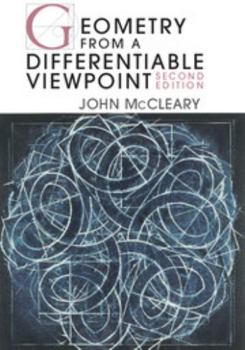Geometry from a Differentiable Viewpoint
Select Format
Select Condition 
Book Overview
The development of geometry from Euclid to Euler to Lobachevsky, Bolyai, Gauss, and Riemann is a story that is often broken into parts - axiomatic geometry, non-Euclidean geometry, and differential geometry. This poses a problem for undergraduates: Which part is geometry? What is the big picture to which these parts belong? In this introduction to differential geometry, the parts are united with all of their interrelations, motivated by the history...
Format:Paperback
Language:English
ISBN:0521133114
ISBN13:9780521133111
Release Date:October 2012
Publisher:Cambridge University Press
Length:368 Pages
Weight:1.90 lbs.
Dimensions:0.9" x 7.0" x 9.9"
Customer Reviews
4 ratings
An excellent transition for the beginning grad student
Published by Thriftbooks.com User , 16 years ago
I agree that this work is bit to terse for those completely uninitiated with the subject. However, for a first semester graduate student (or anyone with about this level of maturity) who has at least a minimal acquaintance with curves/surfaces this is a wonderful book which fulfills a long standing gap. The divide between undergraduate differential geometry and graduate geometry is too great. A beginning graduate student walk into a course on differentiable manifolds and Riemannian Geometry with no undergraduate diff geometry and be fine (as I did). There simply doesn't seem to be anymore that a superficial connection (no pun intended) between the two. This may not trouble the student at first, but as Spivak notes in his tome: "this ignorance of the roots of the subject has its price." Eventually one needs to assimilate the intuition of classical geometry with the technical language of manifolds. This book very elegantly leads the student from his undergraduate education to the doorstep of modern global geometry. As an added bonus, the author also endeavors to bridge the gap between Euclid and differential geometry. The only other successful attempt at this is in Spivak, but unfortunately he goes backwards. Volume 1 is entirely devoted to manifolds. Then in volume 2 he explains the classical point of view and then builds the bridge. While these are beautiful books, this is not efficient for the beginning student. The prospective geometer should read this before a class on manifold theory. I give 4 stars only because the author advertises this as a "first exposure", and this book is simply not suited for this purpose.
great history of geometry book, terrible introductory differential geometry book
Published by Thriftbooks.com User , 17 years ago
Do not buy this inappropriately titled book if you are seeking an introductory text to learn differential geometry. It's not that the concepts in the book are so advanced, so much as not that much space is actually devoted to the subject. The author's real objective is to trace the development of geometry from Euclid to the (relatively) modern formulation of differential geometry, and as a book on that topic it succeeds admirably. The core theme of the book is that efforts to prove the parallel postulate, or, equivalently, show that non-Euclidean geometries are impossible, inadvertently, through their failure, led to the discovery of many fascinating areas of mathematics, such as hyperbolic and Riemannian geometries, and to the development of philosophical ideas about what actually constitutes mathematics and how it is independent from physical reality. The book culminates with the results of Beltrami and Poincare that showed that hyperbolic and Euclidean geometries are logically equivalent, in the sense that if there is a self-contradiction in one then the other is also impossible, thus putting an end to all attempts to disprove hyperbolic geometry. (Unfortunately, Marilyn vos Savant is unaware of this, or at least she was when she wrote an article some years back criticising Andrew Wiles's proof of Fermat's last theorem because it used hyperbolic geometry.) As an appendix, McCleary adds a translation of Riemann's lecture "On the hypothesis which lie at the foundations of geometry," perhaps the most influential single lecture in the history of mathematics (and physics), in which, in the mid-1860s, he presented to a general faculty a talk (involving only a single equation) on the foundations of geometry that anticipated the concepts of a manifold and Riemannian geometry as well as general relativity and even hinted at quantum mechanics. I used this text as a primary reference when conducting an undergraduate seminar on the history of hyperbolic geometry 12 years ago. For this purpose it was suited perfectly, but if you want to learn differential geometry by all means buy one of do Carmo's books or Gallot, Hulin, and LaFontaine.
a great book!
Published by Thriftbooks.com User , 24 years ago
This is a great book. The author develops the differential geometry of curves and surfaces. The endpoint is the vindication of Euclid's parallel postulate. I thoroughly enjoyed reading this book. Very readable.
Excellent text connecting classical to differential geometry
Published by Thriftbooks.com User , 27 years ago
This book is ideal for those with a long time interest in mathematics or the student just becoming interested in advanced topics. It successfully takes the concepts of classic geometry (Euclidean), clearly explains how the parallel postulate interacts with the other postulates and then introduces differential geometry as a natural outgrowth of hyperbolic geometry. McLeary's book succeeds by demonstrating the connection of modern differential geometry to the concepts in which we were educated. This is not a book for the casual reader, but includes many problems and solutions to the more interesting of them






